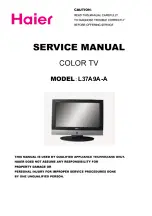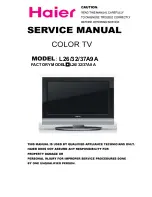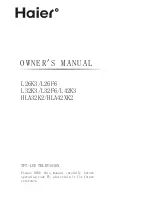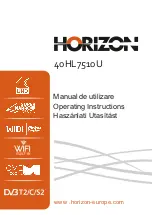
Service Modes, Error Codes, and Fault Finding
EN 19
Q528.1E LA
5.
5.2.3
Customer
S
ervice Mode (C
S
M)
Purpose
When a customer is having problems with his TV-set, he can
call his dealer or the Customer Helpdesk. The service
technician can then ask the customer to activate the CSM, in
order to identify the status of the set. Now, the service
technician can judge the severity of the complaint. In many
cases, he can advise the customer how to solve the problem,
or he can decide if it is necessary to visit the customer.
The CSM is a read only mode; therefore, modifications in this
mode are not possible.
When in this chassis CSM is activated, a colour bar test pattern
will be visible for 5 seconds. This test pattern is generated by
the Pacific3. So if you see this test pattern you can determine
that the back end video chain (Pacific3, LVDS, and display) of
the SSB is working. In case of a set with DFI panel, an extra
test picture is generated. So you will see the Pacific3 test
picture for 3 seconds and then the DFI EPLD test picture for
another 3 seconds. With this extra test picture you can
determine if the DFI board is working properly.
Also new in this chassis: when you activate CSM and there is
a USB stick connected to the TV, the software will dump the
complete CSM content to the USB stick. The file (Csm.txt) will
be saved in the root of your USB stick. This info can be handy
if you do not have picture.
Another new item in this chassis is when CSM is activated, the
complete error-buffer content will be shown via the blinking
LED procedure.
How to Activate CSM
Key in the code “123654” via the standard RC transmitter.
Note
: Activation of the CSM is only possible if there is no (user)
menu on the screen!
How to Navigate
By means of the “CURSOR-DOWN/UP” knob on the RC-
transmitter, you can navigate through the menus.
Contents of CSM
•
S
et Type.
This information is very helpful for a helpdesk/
workshop as reference for further diagnosis. In this way, it
is not necessary for the customer to look at the rear of the
TV-set. Note that if an NVM is replaced or is initialized after
corruption, this set type has to be re-written to NVM.
ComPair will foresee in a possibility to do this.
•
Production Code.
Displays the production code (the serial
number) of the TV. Note that if an NVM is replaced or is
initialized after corruption, this production code has to be
re-written to NVM. ComPair will foresee a in possibility to
do this.
•
Code 1.
Gives the last five errors of the error buffer. As
soon as the built-in diagnose software has detected an
error, the buffer is adapted. The last occurred error is
displayed on the leftmost position. Each error code is
displayed as a 2-digit number. When less than 10 errors
occur, the rest of the buffer is empty (00). See also
paragraph “Error Codes” for a description.
•
Code 2.
Gives the first five errors of the error buffer. See
also paragraph “Error Codes” for a description.
•
Options 1.
Gives the option codes of option group 1 as set
in SAM (Service Alignment Mode).
•
Options 2.
Gives the option codes of option group 2 as set
in SAM (Service Alignment Mode).
•
12NC
SS
B.
Gives an identification of the SSB as stored in
NVM. Note that if an NVM is replaced or is initialized after
corruption, this identification number has to be re-written to
NVM. ComPair will foresee in a possibility to do this. This
identification number consists of 14 characters and is built
up as follows:
- Eight last characters of the 12NC of the SSB itself.
- the serial number of the SSB, which consists of six digits.
Both can be found on a sticker on the PWB of the SSB
itself. The format of the identification number is then as
follows: <last eight characters of 12NC of SSB><serial
number of SSB> (total fourteen characters).
•
Installed date.
Indicates the date of the first installation of
the TV. This date is acquired via time extraction.
•
Digital Natural Motion.
Gives the status of the Digital
Natural Motion setting as set by the customer. Remark : a
customer can choose between “OFF”, “MINIMUM” and
“MAXIMUM”, but in CSM this item will only show “OFF” or
“ON” (“ON” in case the customer has choosen “MINIMUM”
or “MAXIMUM”)
•
Pixel Plus.
Gives the last status of the Perfect Pixel HD
setting, as set by the customer. Possible values are “ON”
and “OFF”. See DFU on how to change this item.
•
DNR.
Gives the last status of the Noise reduction setting,
as set by the customer. Possible values are “OFF”,
“MINIMUM”, “MEDIUM” and “MAXIMUM”. See DFU on
how to change this item.
•
Noise Figure.
Gives an indication of the signal quality for
the selected transmitter. Possible values are “BAD”,
“AVERAGE”, “GOOD“ and “DIGITAL”. In case of a digital
channel, this item will never indicate : “BAD”, “GOOD” or
“AVERAGE” but only displays “DIGITAL”.
•
12NC Display.
Shows the 12NC of the display.
•
Headphone Volume.
Gives the last status of the
headphone volume, as set by the customer. The value can
vary from 0 (volume is minimum) to 100 (volume is
maximum). See DFU on how to change this item.
•
S
urround Mode.
Indicates the by the customer selected
sound mode (or automatically chosen mode). Possible
values are “STEREO” and “VIRTUAL DOLBY
SURROUND”. It can also have been selected
automatically by signalling bits (internal software). See
DFU on how to change this item.
•
AVL.
Indicates the last status of AVL (Automatic Volume
Level) as set by the customer: See DFU on how to change
this item.
•
Delta Volume.
Indicates the last status of the delta volume
for the selected preset as set by the customer: from “-12”
to “+12”. See DFU on how to change this item.
•
Volume.
Indicates the last status of the volume for the
selected preset as set by the customer: from “0” to “100”.
See DFU on how to change this item.
•
Balance.
Indicates the last status of the balance for the
selected preset as set by the customer: from “-10” to “+10”.
See DFU on how to change this item.
•
Preset Lock.
Indicates if the selected preset has a child
lock: “LOCKED” or “UNLOCKED”. See DFU on how to
change this item.
•
Lock after.
Indicates at what time the channel lock is set:
“OFF” or e.g. “18:45” (lock time). See DFU on how to
change this item.
•
Parental rating lock.
Indicates the “Parental rating” as set
by the customer. See DFU on how to change this item.
•
Parental rating status.
Indicates the “Parental rating” as
transmitted by the broadcaster (if applicable). If the
parental rating status is indicating a higher age then the
parental rating lock as set by the customer, you will need to
enter the child lock code.
•
TV ratings lock.
Only applicable for US.
•
Movie ratings lock.
Only applicable for US.
•
On timer.
Indicates if the “On timer” is set “ON” or “OFF”
and when it is set to “ON”, also start time, start day and
program number is displayed. See DFU on how to change
this item.
•
Location.
Gives the last status of the location setting as
set via the installation menu. Possible values are “SHOP”
and “HOME”. If the location is set to “SHOP”, several
settings are fixed. So for a customer location must be set
to “HOME”. Can be changed via the installation menu (see
also DFU).
•
HDMI key validity.
Indicates if the HDMI keys (or HDCP
keys) are valid or not. In case these keys are not valid and
















































